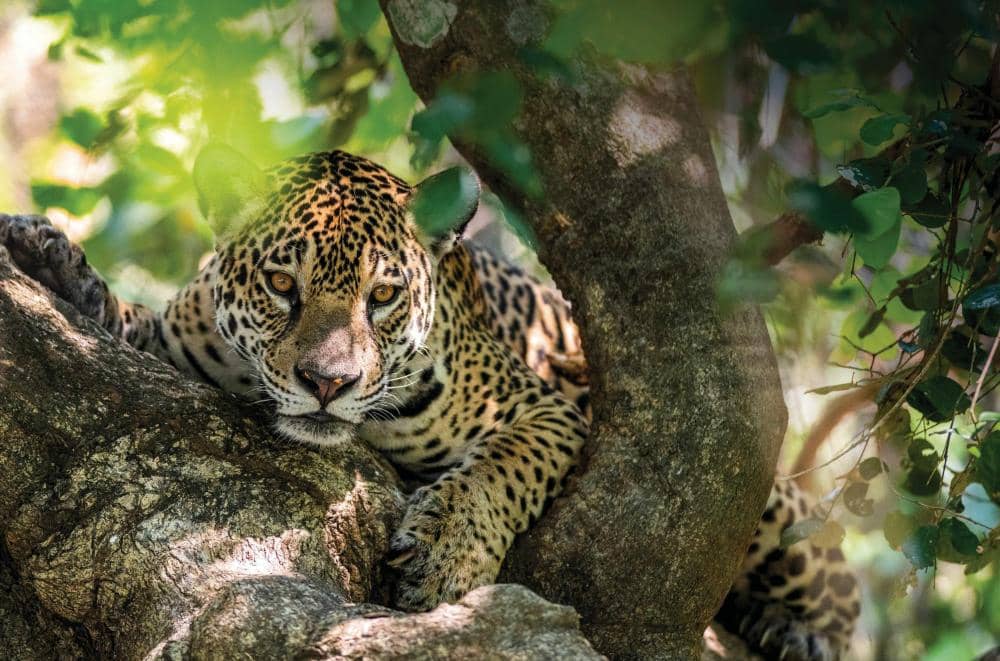
A DOZEN RIVERBOATS HUDDLE AGAINST the bank of a narrow tributary of the Rio Cuiabá in Brazil. The passengers on board jostle soundlessly to get the best view, while their camera lenses reach out like limbs across the water towards a patch of sand on the opposite bank
The mother emerges from the shrub first. She struts out onto the beach with an air of nonchalance. Her two cubs tumble out after her, splashing and play-fighting in the water to the delight of the tourists, who are all hungrily snapping photographs. It's our second jaguar sighting of the day. Given what happened here not too long ago, I can scarcely believe our luck. “Luck?” our guide Fisher Sousa says, raising an eyebrow. “We see jaguars every day.”
In 2020, the Pantanal, the planet's largest tropical wetland - an area larger than England, spanning Brazil, Paraguay and Bolivia - and the home of the highest concentration of jaguars on Earth, was engulfed in flames. Thirty per cent of the biome was scorched beyond recognition. International news reports showed apocalyptic images of wildfires surging through the forest, leaving the charred remains of coati and tapir in their wake. For people like Sousa, working in the Pantanal's developing ecotourism industry, there was a concern about what the fires would mean for the region's flagship species: the jaguar.
The Jaguar ID Project has built up a catalogue of 284 jaguars in the Pantanal's Porto Jofre river system, each one identified by its unique spot pattern. According to Abbie Martin, the project's director, the data on jaguars after the fires paints a promising picture. “After 2020, people seized on this narrative that the jaguars were dying,” she says. “But look at the numbers from 2019 and 2020, and compare them to 2021.”
This story is from the {{IssueName}} edition of {{MagazineName}}.
Start your 7-day Magzter GOLD free trial to access thousands of curated premium stories, and 9,000+ magazines and newspapers.
Already a subscriber ? Sign In
This story is from the {{IssueName}} edition of {{MagazineName}}.
Start your 7-day Magzter GOLD free trial to access thousands of curated premium stories, and 9,000+ magazines and newspapers.
Already a subscriber? Sign In
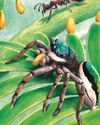
Jump Around - Bagheera Kiplingi - The acrobatic spider with a predilection for veggie food
Spiders eat flies, right? everyone knows that the 45,000 or so spiders in the world are all obligate carnivores, more or less – eating other animals, mainly invertebrates. Nature, however, loves an exception, and one particular spider missed out on that ecological memo. It goes by the wonderful scientific name of Bagheera kiplingi, and its claim to fame is that its diet is – at least mostly – vegetarian.
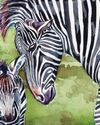
Female of the Species - Zebras - A strong sisterhood is key to staying safe
Zebras are masters of confusion. Their collective noun is ‘a dazzle’, which is fitting since their bodies and behaviour have been surprising scientists for centuries.
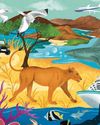
See It, Save It? - Wildlife tourism can be a powerful ally in protecting nature - but it can also harm it. We weigh up the pros and cons.
The sums of wildlife travel aren’t as simple as more tourists equals happier nature. How much did my visit really contribute to the conservation of Lady Liuwa and her habitat – and was that outweighed by carbon emissions from my flights? Did my presence disturb the animals’ natural behaviour more than it reduced the threat of poaching or benefited local communities?The question of whether wildlife travel is, on balance, good for wildlife is a complex one – and there’s no simple answer.

Can Your Really Offset Emissions? - Planning an overseas wildlife-watching trip entails facing some inconvenient truths
Imagine (or maybe you don't need to) that you hanker after the safari trip of a lifetime in sub-Saharan Africa. A 17-day tour beginning at the iconic Victoria Falls, passing through Zimbabwe, Zambia, Malawi and Tanzania, taking in some of the continent’s most wildlife-rich national parks, and ending on the lush island of Zanzibar.

Metamorphosis: a life-changing event
WITH EVOLUTIONARY BIOLOGIST JV CHAMARY
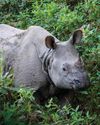
New series for BBC One: Asia
Settle in this autumn for a new natural-history extravaganza on BBC One and iPlayer: the longawaited Asia, presented by Sir David Attenborough.
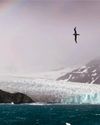
Loss of Antarctic sea ice could impact seabird food supply
Albatrosses and petrels may be forced to fly further to feed
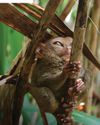
Tarsiers in trouble
Urgent action is needed to ensure survival of the Yoda-like primate

SNAP-CHAT
Chien Lee on shrew loos, rogue drones and being rained out of bed
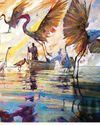
VISIONS OF NATURE
The winners of the Wildlife Artist of the Year competition 2024, from David Shepherd Wildlife Foundation